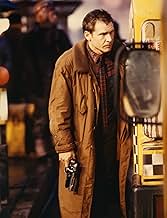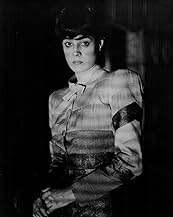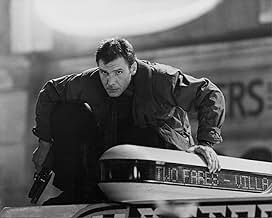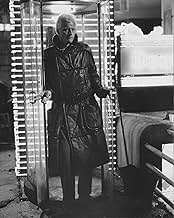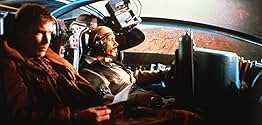A blade runner must pursue and terminate four replicants who stole a ship in space and have returned to Earth to find their creator.A blade runner must pursue and terminate four replicants who stole a ship in space and have returned to Earth to find their creator.A blade runner must pursue and terminate four replicants who stole a ship in space and have returned to Earth to find their creator.
- Nominated for 2 Oscars
- 13 wins & 22 nominations total
Bob Okazaki
- Sushi Master
- (as Robert Okazaki)
- Director
- Writers
- All cast & crew
- Production, box office & more at IMDbPro
Remembering Rutger Hauer (1944-2019)
Remembering Rutger Hauer (1944-2019)
We celebrate the life and legacy of Rutger Hauer, the award-winning actor best known for Blade Runner and The Hitcher.
Storyline
Did you know
- TriviaDirector Sir Ridley Scott and director of photography Jordan Cronenweth achieved the famous "shining eyes" effect by using a technique invented by Fritz Lang and his cinematographer Eugen Schüfftan known as the "Schüfftan Process": light is bounced into the actors' and actresses' eyes off a piece of half-mirrored glass mounted at a forty-five-degree angle to the camera.
- Goofs(at around 9 mins) When we see Deckard waiting for his noodles, he is reading that day's newspaper. Later in Leon's apartment (at around 25 mins), the same newspaper is seen in one of the drawers, except it is old and soiled, as if it has been there for years. We know they are the same since both newspapers have the same headline about farming on the moon.
- Crazy creditsIn the "happy ending" Theatrical/International cuts, the credits play over the gorgeous scenery. In later Director/Final cuts, they play over a normal black background.
- Alternate versionsAll U.S video tape releases before January 1993 are the unrated version and contain the extra violence in the Euro-release that's not seen in the 117 minute American theatrical release:
- When Roy attacks Tyrell we clearly see him pushing his thumbs into Tyrell's eyes, and blood spurting out
- When Pris (Daryl Hannah) attacks Deckard, she reaches down and grabs him by the nostrils
- When Deckard shoots Pris, he shoots 3 times instead of 2
- When Roy pushes the nail through his hand, there is a shot of the nail coming through the skin on the other side.
- ConnectionsEdited into 5 Second Movies: Blade Runner (2009)
- SoundtracksHarps of the Ancient Temples
Composed by Gail Laughton
Performed by Gail Laughton
Courtesy of Laurel Records
Featured review
Blade Runner describes a future in which, through genetics, artificial humans are manufactured and called "replicants"; employees in dangerous jobs and slaves in the outer colonies of the Earth. Made by Tyrell Corporation under the motto "more humans than humans" -especially the "Nexus-6" models- not only resembles humans, they are far superior physically.
The replicants were declared illegal on planet Earth after a bloody mutiny occurred on the planet Mars, where they worked as slaves. A special police force, Blade Runners, is in charge of identifying, tracking and killing - or "withdrawing", in terms of the police itself - the fugitive replicants found on Earth. With a group of replicants loose in Los Angeles, Rick Deckard, the best agent that has existed in regard to the recovery and removal of the replicas, is removed from his semi-retirement to use some of "the old magic blade runner".
Ridley Scott fantastic dark cyberpunk style and futuristic design is so well made that accomplished to create a visual vocabulary: neon lights, abandonment, decay, loneliness, obscurity, indifference and alienation are the core of the aesthetics of the film, which will eventually become and serve as a pattern for successive cinematographic works.
The script David Webb Peoples adapted from 'Do Androids Dream of Electric Sheep?' takes the viewer into a dwelling and philosophical controversy, as it creates doubt and empathy to the so called replicants, primarily as seen in many shots of Rick Deckard hesitating about the true nature of his task.
Harrison Ford and Rutger Hauer haunts the attention into the essence of the story. Their characterization throughout infiltrates the different conceptions of life. A saddened soul searching for the meaning of his punished existence and the other, ruminating a task sinking him into a moral void brimming with guilt.
At the end, the movie leaves you wondering about the implications the creation of highly intelligent beings (IA) must have and, if it's worth treating them as machines or they have become so human that the difference is non existent.
"Time... to die".
10/10.
The replicants were declared illegal on planet Earth after a bloody mutiny occurred on the planet Mars, where they worked as slaves. A special police force, Blade Runners, is in charge of identifying, tracking and killing - or "withdrawing", in terms of the police itself - the fugitive replicants found on Earth. With a group of replicants loose in Los Angeles, Rick Deckard, the best agent that has existed in regard to the recovery and removal of the replicas, is removed from his semi-retirement to use some of "the old magic blade runner".
Ridley Scott fantastic dark cyberpunk style and futuristic design is so well made that accomplished to create a visual vocabulary: neon lights, abandonment, decay, loneliness, obscurity, indifference and alienation are the core of the aesthetics of the film, which will eventually become and serve as a pattern for successive cinematographic works.
The script David Webb Peoples adapted from 'Do Androids Dream of Electric Sheep?' takes the viewer into a dwelling and philosophical controversy, as it creates doubt and empathy to the so called replicants, primarily as seen in many shots of Rick Deckard hesitating about the true nature of his task.
Harrison Ford and Rutger Hauer haunts the attention into the essence of the story. Their characterization throughout infiltrates the different conceptions of life. A saddened soul searching for the meaning of his punished existence and the other, ruminating a task sinking him into a moral void brimming with guilt.
At the end, the movie leaves you wondering about the implications the creation of highly intelligent beings (IA) must have and, if it's worth treating them as machines or they have become so human that the difference is non existent.
"Time... to die".
10/10.
- SantiagoDM1
- Aug 19, 2018
- Permalink
Women in Science Fiction
Women in Science Fiction
Whether they are exploring the stars, escaping dystopias, or making the world a better place, these women are what science fiction is all about.
Details
- Release date
- Countries of origin
- Official site
- Languages
- Also known as
- Dangerous Days
- Filming locations
- Production companies
- See more company credits at IMDbPro
Box office
- Budget
- $28,000,000 (estimated)
- Gross US & Canada
- $32,914,489
- Opening weekend US & Canada
- $6,150,002
- Jun 27, 1982
- Gross worldwide
- $41,757,358
- Runtime1 hour 57 minutes
- Color
- Sound mix
- Aspect ratio
- 2.39 : 1
Contribute to this page
Suggest an edit or add missing content









